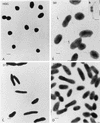Characterization of marine temperate phage-host systems isolated from Mamala Bay, Oahu, Hawaii
- PMID: 9464390
- PMCID: PMC106079
- DOI: 10.1128/AEM.64.2.535-542.1998
Characterization of marine temperate phage-host systems isolated from Mamala Bay, Oahu, Hawaii
Abstract
To understand the ecological and genetic role of viruses in the marine environment, it is critical to know the infectivity of viruses and the types of interactions that occur between marine viruses and their hosts. We isolated four marine phages from turbid plaques by using four indigenous bacterial hosts obtained from concentrated water samples from Mamala Bay, Oahu, Hawaii. Two of the rod-shaped bacterial hosts were identified as Sphingomonas paucimobilis and Flavobacterium sp. All of the phage isolates were tailed phages and contained double-stranded DNA. Two of the phage isolates had morphologies typical of the family Siphoviridae, while the other two belonged to the families Myoviridae and Podoviridae. The head diameters of these viruses ranged from 47 to 70.7 nm, and the tail lengths ranged from 12 to 146 nm. The burst sizes ranged from 7.8 to 240 phage/bacterial cell, and the genome sizes, as determined by restriction digestion, ranged from 36 to 112 kb. The members of the Siphoviridae, T-phi HSIC, and T-phi D0, and the member of the Myoviridae, T-phi D1B, were found to form lysogenic associations with their bacterial hosts, which were isolated from the same water samples. Hybridization of phage T-phi HSIC probe with lysogenic host genomic DNA was observed in dot blot hybridization experiments, indicating that prophage T-phi HSIC was integrated within the host genome. These phage-host systems are available for use in studies of marine lysogeny and transduction.
Figures





Similar articles
-
Prophage distribution in coryneform bacteria.Res Microbiol. 1995 Jul-Aug;146(6):493-505. doi: 10.1016/0923-2508(96)80295-6. Res Microbiol. 1995. PMID: 8525066
-
Characterization of the temperate bacteriophage phi adh and plasmid transduction in Lactobacillus acidophilus ADH.Appl Environ Microbiol. 1989 Sep;55(9):2206-13. doi: 10.1128/aem.55.9.2206-2213.1989. Appl Environ Microbiol. 1989. PMID: 2508554 Free PMC article.
-
Enterococcal Bacteriophages and Genome Defense.2014 Feb 11. In: Gilmore MS, Clewell DB, Ike Y, Shankar N, editors. Enterococci: From Commensals to Leading Causes of Drug Resistant Infection [Internet]. Boston: Massachusetts Eye and Ear Infirmary; 2014–. 2014 Feb 11. In: Gilmore MS, Clewell DB, Ike Y, Shankar N, editors. Enterococci: From Commensals to Leading Causes of Drug Resistant Infection [Internet]. Boston: Massachusetts Eye and Ear Infirmary; 2014–. PMID: 24649501 Free Books & Documents. Review.
-
Genomic characterization of a temperate phage of the psychrotolerant deep-sea bacterium Aurantimonas sp.Extremophiles. 2015 Jan;19(1):49-58. doi: 10.1007/s00792-014-0702-5. Epub 2014 Oct 30. Extremophiles. 2015. PMID: 25354565
-
Tailed bacteriophages: the order caudovirales.Adv Virus Res. 1998;51:135-201. doi: 10.1016/s0065-3527(08)60785-x. Adv Virus Res. 1998. PMID: 9891587 Free PMC article. Review.
Cited by
-
Optimization of procedures for counting viruses by flow cytometry.Appl Environ Microbiol. 2004 Mar;70(3):1506-13. doi: 10.1128/AEM.70.3.1506-1513.2004. Appl Environ Microbiol. 2004. PMID: 15006772 Free PMC article.
-
Real-time PCR quantification of human adenoviruses in urban rivers indicates genome prevalence but low infectivity.Appl Environ Microbiol. 2005 Nov;71(11):7426-33. doi: 10.1128/AEM.71.11.7426-7433.2005. Appl Environ Microbiol. 2005. PMID: 16269784 Free PMC article.
-
Phage specificity of the freshwater fish pathogen Flavobacterium columnare.Appl Environ Microbiol. 2011 Nov;77(21):7868-72. doi: 10.1128/AEM.05574-11. Epub 2011 Sep 2. Appl Environ Microbiol. 2011. PMID: 21890667 Free PMC article.
-
Gene transfer by transduction in the marine environment.Appl Environ Microbiol. 1998 Aug;64(8):2780-7. doi: 10.1128/AEM.64.8.2780-2787.1998. Appl Environ Microbiol. 1998. PMID: 9687430 Free PMC article.
-
Prophylactic Bacteriophage Administration More Effective than Post-infection Administration in Reducing Salmonella enterica serovar Enteritidis Shedding in Quail.Front Microbiol. 2016 Aug 9;7:1253. doi: 10.3389/fmicb.2016.01253. eCollection 2016. Front Microbiol. 2016. PMID: 27555842 Free PMC article.
References
-
- Ackermann H W, DuBow M S. Viruses of prokaryotes. 1. General properties of bacteriophages. Boca Raton, Fla: CRC Press; 1987.
-
- Barnet Y M, Humphrey B. Exopolysaccharide depolymerase induced by Rhizobium bacteriophage. Can J Microbiol. 1975;21:1647–1650. - PubMed
-
- Bergh Ø, Børsheim K Y, Bratbak G, Helda M. High abundance of viruses found in aquatic environments. Nature. 1989;340:467–468. - PubMed
-
- Børsheim K Y. Native marine bacteriophages. FEMS Microbiol Ecol. 1993;102:141–159.
-
- Bratbak G, Heldal M, Thingstad T F, Riemann B, Haslund O H. Incorporation of viruses into the budget of microbial C-transfer. A first approach. Mar Ecol Prog Ser. 1992;83:273–280.
Publication types
MeSH terms
LinkOut - more resources
Full Text Sources

